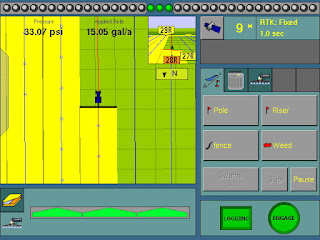 We ridge plant all of our crops, which means that we do no tillage in the spring. We do have other tasks to keep us busy though. First we apply dry fertilizer to the fields. We only apply what each field needs, based on soil fertility test done last fall by our agronomist. When we apply the fertilizer rate to an entire field I use a machine that looks much like a lawn fertilizer spreader. The nutrients we mostly apply with dry fertilizer is phosphorus, potassium, sulfur and zinc. Most of our nitrogen fertilizer is applied as a liquid, and most of that is put on during the growing season.
We ridge plant all of our crops, which means that we do no tillage in the spring. We do have other tasks to keep us busy though. First we apply dry fertilizer to the fields. We only apply what each field needs, based on soil fertility test done last fall by our agronomist. When we apply the fertilizer rate to an entire field I use a machine that looks much like a lawn fertilizer spreader. The nutrients we mostly apply with dry fertilizer is phosphorus, potassium, sulfur and zinc. Most of our nitrogen fertilizer is applied as a liquid, and most of that is put on during the growing season.Many of our fields have been grid sampled, where our agronomist takes separate soil samples from small squares inside of the entire field. They may end up with 30-40 different soil fertility tests per field. Then they prescribe different amounts of fertilizer to each area. On these fields I hire our local coop to apply the dry fertilizer since they have the machine that can vary the dry fertilizer rates as they drive across the field. This saves money, fertilizer and improves yields; a win, win, win.
The next step for us is to shred the corn stalks left from last year. We do rent our corn stalks to a neighbor with cows to graze during the winter. The cows do eat quite a bit of the refuse left from last year's crop, but they do not eat the corn stalks. They need to be chopped up to make cultivating easier later in the year. We use a Rhino shredder that shreds 6 rows at a time.
Then we spray all of our fields with a herbicide package to kill winter annuals (dandelion, tansymustard, field pennycress and others) and stop early sprouting spring weeds. On fields going to corn we spray the herbicide mixture with a base of 32% liquid nitrogen. This heats up the herbicide mix (works faster) and gives the soon to be planted corn an early boost. Our sprayer covers 20 rows at a time and is 60 feet wide. Turning on ends of fields can be tricky if you don't watch what you are doing.
We use a Trimble guidance computer on all our tractors. This is a screenshot of me spraying a field. It keeps the tractor and sprayer on the right path and eliminates overlap. It also controls how much spray is going on the field. If I speed up or slow down it resets the valves so I put on exactly what I want, in this case, 15 gallons per acre (upper center of screen). It also turns the spray boom on and off on the ends, and if the field has a diagonal end it turns them on and off in sequence to avoid any more overlap than necessary.
That's it for today. When I start planting I'll write about that.



No comments:
Post a Comment